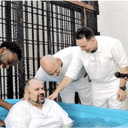Monday, June 12, 2006
BY RICHARD D. POMPELIO
Editorial
When capital punishment was reinstated in New Jersey more than a quarter-century ago, it was applauded as a declaration by our elected officials that they were going to be tough on crime. It has evolved, however, into an ideological war between the courts and the Legislature. It is a war with many casualties, including crime victims who are constantly caught in its crossfire. It is time to end this war. The death penalty process in the courts of New Jersey revictimizes crime victims by keeping them in the criminal justice system for as many as 20 years, with the re sult being the same: a reversal of the trial jury’s death penalty verdict. This judicial process is an insult to survivors of murder and a disservice to the taxpayers who fund this travesty. It is time to bring some sanity to a law that by virtue of its implementation by those in power has no sanity.
Since the death penalty law was re-enacted in New Jersey in 1982, no one has been executed. There have been 197 death penalty trials, and juries have voted beyond a reasonable doubt to send 60 killers to the death chamber. One by one, our state Supreme Court has de vised ways to block the path. And if one conviction survives Supreme Court review, there is always the federal court to set things right. Robert Marshall, convicted in connection with the murder of his wife at a Garden State Parkway rest stop in 1984, recently moved off death row. Twenty years after the crime, a federal appeals court said he was entitled to a new hearing on whether he deserved the death penalty. Reassembling all the evi dence and witnesses would be nearly impossible. The prosecutor decided not to pursue the case, effectively leaving Marshall with a 30-year sentence.
Today, only 10 killers remain on death row in New Jersey.
In 1982, Walter Gerald and his accomplice broke into the home of 89-year-old John Matusz. In less than one hour, Gerald had savagely beaten John’s daughter and his disabled son Paul, who ultimately died. Gerald then stomped John on his face with such force that he left the imprint of his sneaker on the victim’s face. Finally, to be sure that John would not survive to identify him, Gerald dropped a television on his head. Gerald was identified as the killer because the imprint of his sneaker matched the marks on the victim’s face. He pleaded guilty to the murders and, after the death penalty trial, the jury unanimously voted for death.
Six years after the murder, the case went before the New Jersey Supreme Court, and the death penalty was reversed, sparing the killer’s life. The court held that the jury’s decision was not clear as to whether Gerald intended to kill his victim or just cause him bodily harm. The “Gerald rule” was then employed by the Supreme Court to reverse other death penalty convictions, including one in which the killer stabbed his female victim more than 50 times.
The Gerald case and others like it ignited the war over capital punishment between the courts and the Legislature that continues to this day. Frustrated by these judi cial decisions, the Legislature brought this rule-of-intent issue be fore the public, and in 1992 by an overwhelming vote of 1.8 million to 600,000, the people voted to amend the New Jersey Constitution to overrule the Gerald decision. JoAnne Barlieb, the oldest of four daughters, was just 8 when her mother was murdered. The first and second death penalty convic tions were reversed by the Supreme Court, and 17 years later at the third death penalty trial, the killer’s life was spared as he told the jury that he counseled killers to have sympathy for their victims. JoAnn, 25 at the time of the last trial in 2002, had to fight to be permitted to stay in the courtroom to observe the trial proceedings.
To this day, she and her family bear the emotional scars of their 17-year nightmare in the justice system.
Several years ago, I assisted the families of Jeremy Giordano and Giorgio Gallara, who were executed by two thugs who wanted to grow up to be hit men for the mob. The killers ordered pizzas from Gallara’s restaurant, and when the victims delivered them, the killers jumped out of the bushes and killed them. The death penalty trial of one of the killers resulted in a jury verdict of death. The trial judge stunned everyone, including the legal community, by announc ing, without any legal basis, that if the killer was not executed within five years, the death sentence was to be commuted to life in prison.
As the victims’ families, confused, crushed and frightened, looked to me and asked if what the judge did was right, I could only respond “no” and “He will be reversed on appeal.” Months later, the judge’s decision was reversed by the appellate court because it was clearly wrong. Nevertheless, this process of justice was just one more example of a long list of injus tices to victims when the death penalty was involved.
The New Jersey Supreme Court ultimately reversed the death penalty conviction of the murderer based on several reasons, one being that it was improper for the trial court to have Jeremy Giordano’s mother testify that she wanted the jury to spare the killer’s life. These stories are tragic, and unfortunately, I have too many of them to tell.
Too often the survivors of this carnage share with me the unimaginable pain they have suffered after being thrust into a justice system that they cannot escape and one that is all about the killer, with little value placed on the impact of the process on the survivors. Since capital punishment was reinstated in 1982, New Jersey has spent over a quarter-billion dollars on death penalty cases. That is an average of more than $10 million a year of taxpayers’ money.
As each death row killer has an average of more than $1 million of our tax dollars spent on his defense, how much do the victims get? Next to nothing.
A law in New Jersey on the books since 2000 is supposed to provide college scholarships for survivors of murder. To this day, the Legislature has failed to appropriate one penny toward this scholarship fund. Furthermore, the victims’ rights movement has been kept alive in New Jersey over the past quarter-century primarily by the nonprofit, grassroots organizations founded by crime victims.
These organizations continue to struggle to keep their doors open so they can serve crime victims at no cost. How much money is spent by the state on keeping them going so they can assist victims? Again, the answer is the same: next to nothing.
My solution to the death penalty problem is simple. Abolish the death penalty now in favor of life without parole. From the $10 million a year average sum we have wasted on these killers, appropriate $1 million to support the victim scholarship fund and the nonprofit groups that serve victims at no cost. Take the other $9 million and apply it to help reduce our budget deficit.
The New Jersey Constitution requires that crime victims be treated with “fairness, compassion and respect” by our criminal justice system. The death penalty process has continually caused a violation of these rights by treating victims as mere appendages to a system that is primarily about criminals. So if anyone is looking to find a real reason to abolish the death penalty, just think of the victims. They don’t deserve any more injustice.
Richard D. Pompelio, a lawyer, is executive director of the New Jersey Crime Victims’ Law Center.



